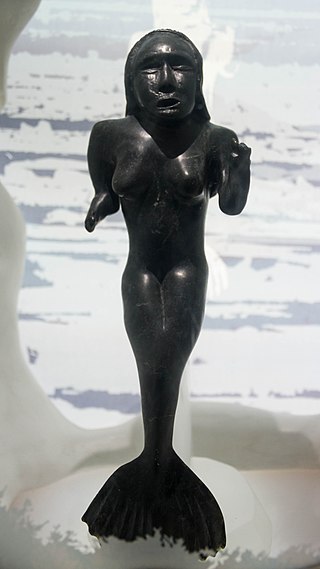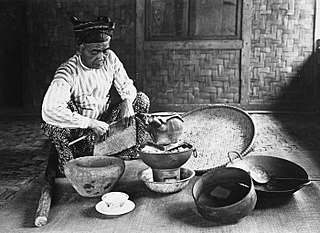Related Research Articles

Shamanism or Samanism is a religious practice that involves a practitioner interacting with the spirit world through altered states of consciousness, such as trance. The goal of this is usually to direct spirits or spiritual energies into the physical world for the purpose of healing, divination, or to aid human beings in some other way.

Spirit possession is an unusual or altered state of consciousness and associated behaviors purportedly caused by the control of a human body by spirits, ghosts, demons, or gods. The concept of spirit possession exists in many cultures and religions, including Buddhism, Christianity, Haitian Vodou, Hinduism, Islam, Wicca, and Southeast Asian, African, and Native American traditions. Depending on the cultural context in which it is found, possession may be considered voluntary or involuntary and may be considered to have beneficial or detrimental effects on the host.

Inuit religion is the shared spiritual beliefs and practices of the Inuit, an indigenous people from Alaska, northern Canada, parts of Siberia and Greenland. Their religion shares many similarities with some Alaska Native religions. Traditional Inuit religious practices include animism and shamanism, in which spiritual healers mediate with spirits. Today many Inuit follow Christianity, but traditional Inuit spirituality continues as part of a living, oral tradition and part of contemporary Inuit society. Inuit who balance indigenous and Christian theology practice religious syncretism.
The Blackfeet are a tribe of Native Americans who currently live in Montana and Alberta. They lived northwest of the Great Lakes and came to participate in Plains Indian culture.

Itako, also known as ichiko (市子) or ogamisama (オガミサマ), are blind women who train to become spiritual mediums in Japan. Training involves severe ascetic practices, after which the woman is said to be able to communicate with Japanese Shinto spirits, kami, and the spirits of the dead. Itako perform rituals tied to communication with the dead and divination. The practice has been on the decline, with only 20 living itako in Japan, all more than 40 years old.

A witch doctor was originally a type of healer who treated ailments believed to be caused by witchcraft. The term is now more commonly used to refer to healers, particularly in regions which use traditional healing rather than contemporary medicine.

Filipino witches are the users of black magic and related practices from the Philippines. They include a variety of different kinds of people with differing occupations and cultural connotations which depend on the ethnic group they are associated with. They are completely different from the Western notion of what a witch is, as each ethnic group has their own definition and practices attributed to witches. The curses and other magics of witches are often blocked, countered, cured, or lifted by Filipino shamans associated with the indigenous Philippine folk religions.

Ayyavazhi rituals are the religious practices prevalent among the followers of Ayyavazhi. Most of them are connected with Akilam and Arul Nool and a few, though not associated with the holy books, are practiced for over a century right from the beginning of Ayyavazhi. Some practices are unique for Pathis and some others are common for all worship centres.

Filipino shamans, commonly known as Babaylan, were shamans of the various ethnic groups of the pre-colonial Philippine islands. These shamans specialized in communicating, appeasing, or harnessing the spirits of the dead and the spirits of nature. They were almost always women or feminized men. They were believed to have spirit guides, by which they could contact and interact with the spirits and deities and the spirit world. Their primary role were as mediums during pag-anito séance rituals. There were also various subtypes of babaylan specializing in the arts of healing and herbalism, divination, and sorcery.
The polong is a type of familiar spirit in Malay folklore. It has the appearance of a miniature woman, the size of the first joint of the finger.

A dukun is an Indonesian term for shaman. Their societal role is that of a traditional healer, spirit medium, custom and tradition experts and on occasion sorcerers and masters of black magic. In common usage the dukun is often confused with another type of shaman, the pawang. It is often mistranslated into English as "witch doctor" or "medicine man". Many self-styled dukun in Indonesia are simply scammers and criminals, preying on people who were raised to believe in the supernatural.
The Nahua of La Huasteca is an indigenous ethnic group of Mexico and one of the Nahua peoples. They live in the mountainous area called La Huasteca which is located in north eastern Mexico and contains parts of the states of Hidalgo, Veracruz and Puebla. They speak one of the Huasteca Nahuatl dialects: western, central or eastern Huasteca Nahuatl.
Yorùbá medicine, or egbòogi, is an Yoruba system of herbalism practiced primarily in West Africa and the Caribbean.

The Jivaroan peoples are the indigenous peoples in the headwaters of the Marañon River and its tributaries, in northern Peru and eastern Ecuador. The tribes speak the Chicham languages.
Wu is a Chinese term translating to "shaman" or "sorcerer", originally the practitioners of Chinese shamanism or "Wuism".

Shamanism among Alaska Natives was particularly important as it served to construct their special connection to their land, and a kinship with the animals with whom they share that land. Before the introduction of western culture and the religions that are now practiced in Alaska, there was a common spiritual connection made with the people to the land they occupied. The most common name for this connection is shamanism. Shamanism differs in every culture where it is practiced, in Alaska it is centered in the animals that are common in the area. Through the use of many myths, stories, and ceremonies these animals are personified and their spirits made tangible and in turn are deeply woven within the Native Alaska people today. It was through the shaman that the spirit world was connected to the natural world. A shaman in Alaska Native culture was a mediator, healer and the spirit worlds’ mouthpiece. Although shamanism is no longer popularly practiced, it was and continues, to be the heart of the Native Alaskan people.
Emotional flooding is a form of psychotherapy that involves attacking the unconscious and/or subconscious mind to release repressed feelings and fears. Many of the techniques used in modern emotional flooding practice have roots in history, some tracing as far back as early tribal societies. For more information on emotional flooding, see Flooding (psychology).

Tsentsak are invisible pathogenic projectiles or magical darts utilized in indigenous and mestizo shamanic practices for the purposes of sorcery and healing throughout much the Amazon Basin. Anthropologists identify them as objects referenced in emic accounts that represent indigenous beliefs. Tsentak are not recognized in scientific medicine.
Fugara or Fuqara are shaman or people with supernatural powers in Bedouin shamanism. Fugara means 'weak' as these individuals are known to avoid hefty meals. They are masters of desert mysticism and are believed to have access to the spiritual realm. They provide advice, teaching or spiritual insight to entire tribes, along with tending to the sick.

The Durin-gut, also called the Michin-gut and the Chuneun-gut, is the healing ceremony for mental illnesses in the Korean shamanism of southern Jeju Island. While commonly held as late as the 1980s, it has now become very rare due to the introduction of modern psychiatry.
References
- Lewis Spence, An Encyclopedia of Occultism, Routledge, London, 1988